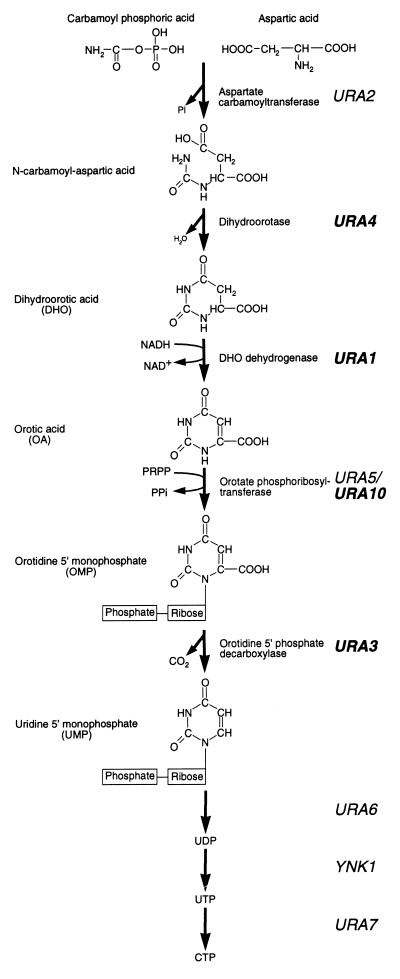Part:BBa_K2407301
Ura3 gene
This is the part regulatory region from the URA3 gene coding for OMP decarboxylase, an essential protein in the uracil synthesis pathway in S. cerevisiae budding yeast. It is widely used as a nutrition tag in Saccharomyces cerevisiae.
Description
URA3, a gene on chromosome V in Saccharomvces cerevisiae, is widely used in researches concerning yeasts as a “marker gene” (systematic name YEL021W. URA3) and used as a label for chromosomes or plasmids. URA3 encodes Orotidine 5'-phosphate decarboxylase—an enzyme that catalyzes one reaction in the synthesis of pyrimidine ribonucleotides. We obtained the URA3 gene from the PRS416 plasmid,which worked as a vector for our functional genes.
Principle of operation
1) Pyrimidine biosynthetic pathway of S. cerevisiae
In Saccharomyces cerevisiae, the biosynthesis of pyrimidines involves the de novo synthesis of UMP from glutamine. Carbamoyl phosphate, derived from glutamine, undergoes a condensation reaction with aspartic acid, resulting in the formation of N-carbamoyl aspartic acid. Both the formation and subsequent condensation of carbamoyl phosphate are performed by Ura2p. The pyrimidine ring of N-carbamoyl aspartic acid is closed by the elimination of water to form dihydroorotic acid (DHO), which is subsequently oxidized to form orotic acid (OA), and a ribose-phosphate group is then added to form orotidine 5′-monophosphate (OMP). The formation of OMP is performed by two isoenzymes, Ura5p and Ura10p. OMP is then decarboxylated to yield UMP, which may subsequently be processed to form other pyrimidines. Regulation of this pathway occurs at several levels. First, UTP down-regulates the enzymatic activity of Ura2p and transcription of the URA2 gene. Second, under conditions of pyrimidine starvation, transcription of the URA1, URA3, URA4, and URA10 genes (the URA genes) is increased some three- to eightfold. This increase in transcription is dependent on a transcriptional activator, Ppr1p.
2) Usage in yeast research
The URA3 gene in the yeasts used in lab has already been deleted. Hence the loss of ODCase activity leads to a lack of cell growth unless uracil or uridine is added to the media. The presence of the URA3 gene in yeast restores ODCase activity, facilitating growth on media not supplemented with uracil or uridine, thereby allowing selection for yeast carrying the gene. In contrast, if 5-FOA (5-Fluoroorotic acid) is added to the media, the active ODCase will convert 5-FOA into the toxic compound (a suicide inhibitor) 5-fluorouracil causing cell death, which allows for selection against yeast carrying the gene.
Since URA3 allows for both positive and negative selection, it has been developed as a genetic marker for DNA transformations and other genetic techniques in bacteria and many fungal species. It is one of the most important genetic markers in yeast genetic modification. While URA3 is a powerful selectable marker it has a high background. This background is because cells that pick up mutations in URA3 may also grow on 5-FOA. Colonies should be verified by a second assay such as PCR to confirm the desired strain has been created.
Characterization
Positive selection
For characterizing the positive selecting function of URA3 part, we designed the following experiment:
(1) Incubate 2 test tubes of yeasts-BY4741, and numbered as #1, #2. (cultured in YPD, 30℃,6 months)
(2) After incubation, the yeasts in #1 tube are transformed by PRS416 plasmid, which contains URA3 gene as report gene.
(3) Two groups of yeasts are spread on two Sc-URA plates, and hatch in the 30℃ incubator for 48 hr.
(4) Examine the growth situation of yeasts on both plates.
Showed in the photograph above, yeasts in group 1#, with PRS416 plasmid, has proliferated on the Sc-URA plate. Meanwhile, the other group without URA3 gene are not able to grow on the Sc-URA plate. The result indicates the URA3 gene is necessary for our yeasts (BY4741) to grow and proliferate on media not supplemented with uracil, thereby allowing selection for yeast carrying the gene.
negative selection
In order to characterize the negative selecting function of URA3 gene, after the transformation of #1 yeasts, we also spread the yeasts of group 1 on a 5-FOA plate, and spread group 2 yeasts on another 5-FOA plate in the meantime as control.
As presented above, yeasts #1(with URA3 gene) haven’t amplified in the 5-FOA plate, while yeasts #2 can proliferate on it, which testified the negative selecting function of URA gene.
Reference
[1] Wikipedia-URA3 gene. https://en.wikipedia.org/wiki/URA3.
[2] Flynn, P. J.; Reece, R. J. (1999). "Activation of transcription by metabolic intermediates of the pyrimidine biosynthetic pathway". Molecular and Cellular Biology. 19.
Usage and Biology
Sequence and Features
- 10COMPATIBLE WITH RFC[10]
- 12COMPATIBLE WITH RFC[12]
- 21COMPATIBLE WITH RFC[21]
- 23COMPATIBLE WITH RFC[23]
- 25COMPATIBLE WITH RFC[25]
- 1000INCOMPATIBLE WITH RFC[1000]Illegal BsaI site found at 669
Illegal SapI.rc site found at 516
| chassis | Saccharomyces cerevisiae |




